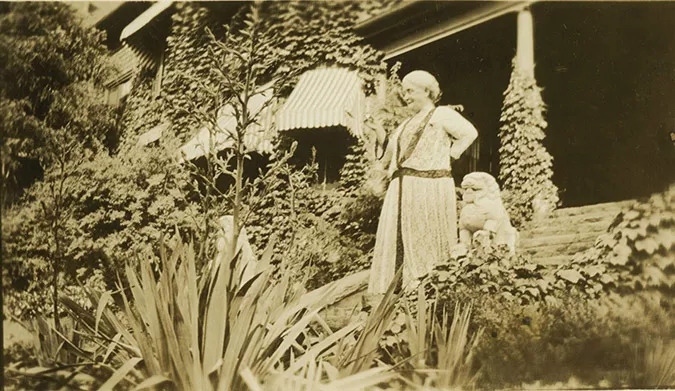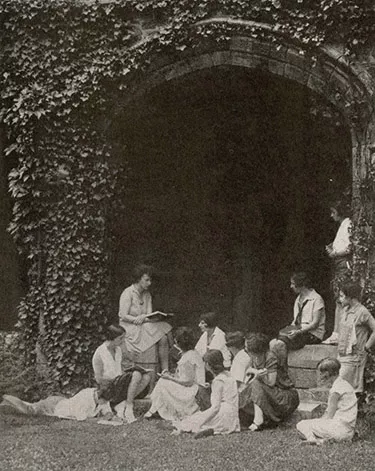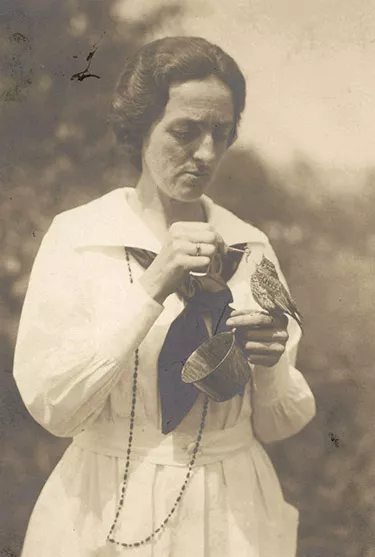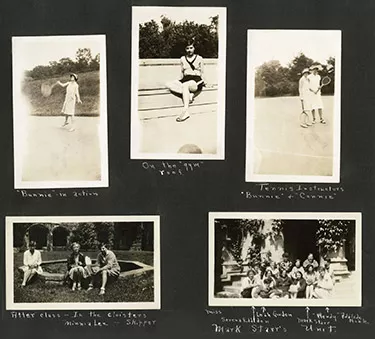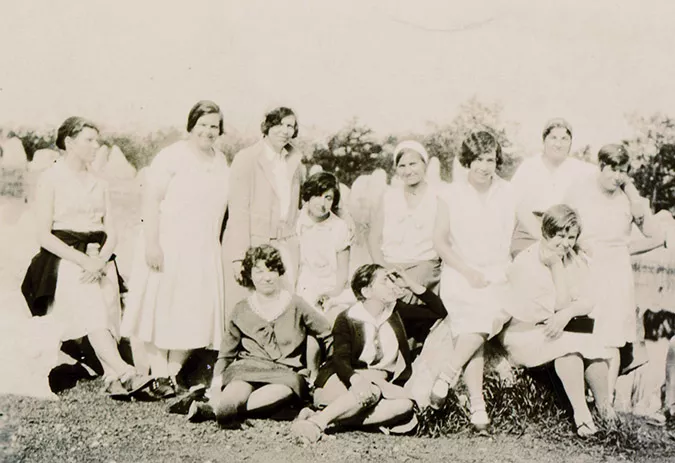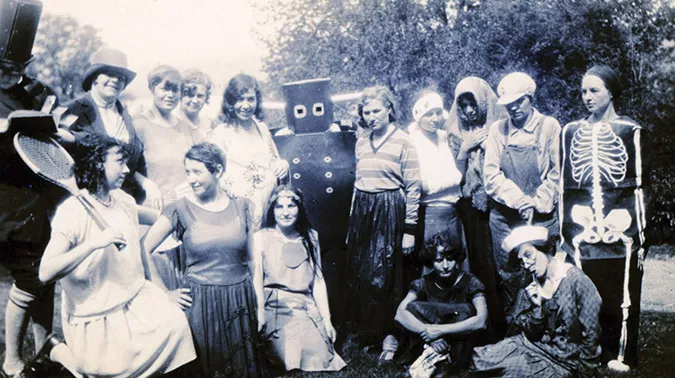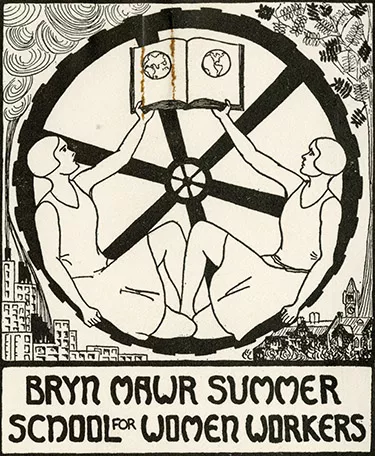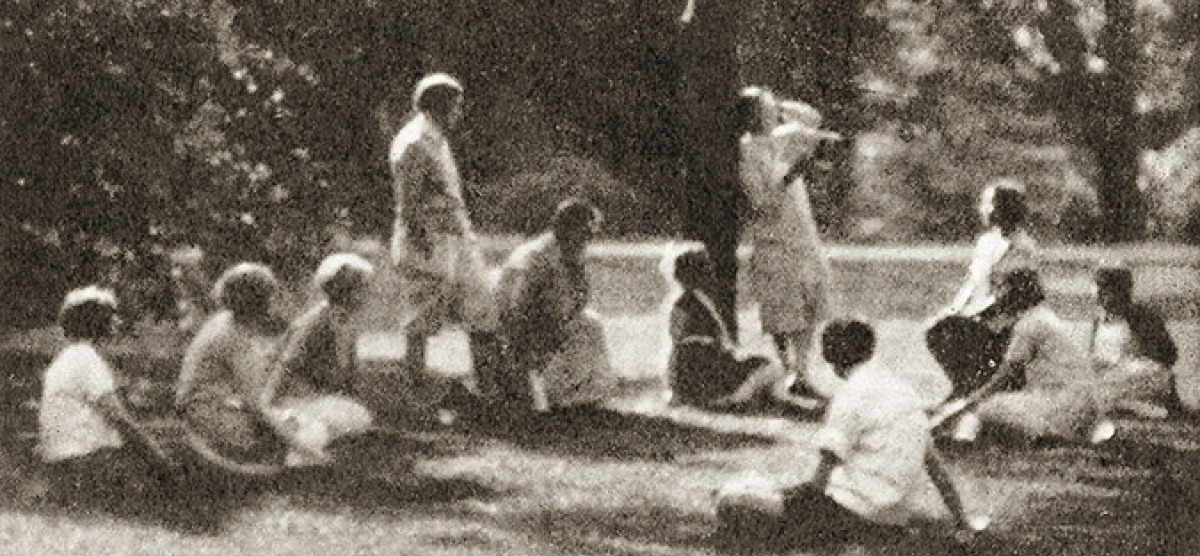
For Roses, Too
Tracing the history of the Bryn Mawr Summer School for Women Workers in Industry.
What would it mean for women working in factories to experience eight weeks of residential education on Bryn Mawr’s campus? How could an elite college support efforts to educate industrial workers? Three decades after the founding of Bryn Mawr College, these questions became the basis of an experiment that was both a product of its time and one that left a powerful legacy.
The Bryn Mawr Summer School for Women Workers in Industry, during its time on campus from 1921 through 1938, brought more than 100 women factory workers to campus each summer for eight weeks. The Summer School enrolled immigrants from Southern and Eastern Europe, Jewish factory workers from New York, poor white textile workers from the South, and Black workers from across the country. It was started to offer young working-class women an introduction to advanced education, but it also became an important training ground for labor activists.
Curator Beck Morawski ’21 has designed an extensive digital exhibit, For Roses, Too, that provides an overview of the Summer School and its history and asks readers what lessons they can take from its history to apply to Bryn Mawr College today. “While the past of 1921 may seem distant,” Morawski says, “recurring themes of student activism and strikes, calls for racial equality, outcry against police brutality, and a longing for a return to Bryn Mawr’s campus are concepts that current students grapple with to this day.”
Here are condensed excerpts. Click here to see the full exhibit.
Founding and Early Figures
The idea for the Bryn Mawr Summer School for Women Workers in Industry is attributed to M. Carey Thomas, the first female president of Bryn Mawr College. The Summer School was to be a serious departure from Thomas’s selective vision of the College, which accepted almost exclusively upper-class, white, Christian students under her guidance. Thomas’s plans toward worker’s education were not necessarily viewed by her or her contemporaries as aligned with the labor movement, instead reflecting a hope for a sense of unity among educated and uneducated white women.
Thomas arranged a meeting with leaders in the American labor movement to discuss the best means of founding the Summer School for Women Workers in Industry, but also tapped Dean of Students Hilda “Jane” Worthington Smith to attend. Smith’s work was already devoted to helping those in need and acted beyond the reach of traditional philanthropy (see Lore, page 11). As the Constitution of the School was written, it was codified with the thought in mind that no static program could properly suit the needs of women in industry; only a program that listened to its attendees.
Curriculum and Education
During the School’s first session in the summer of 1921, a committee of students was brought on to help refine how best to teach women workers in industry. A student body with drastically different needs and wants from the traditional, wealthy young women who spent fall and spring on campus, they were eager to have a say in the makeup of their time on campus.
It was this self-directed push that shaped the program into what it became, an interdisciplinary educational retreat for workers that provided an education in English, music studies, economics, sociology and psychology, personal wellness, and the natural sciences, among other subjects.
Professors often came from colleges other than Bryn Mawr and were encouraged to teach at the Bryn Mawr Summer School for only a year or two at a time, with the hopes that they would go on to use the experience they had gained to help start workers’ schools of their own. Several programs using Bryn Mawr’s model sprung up around the country, with some of the most notable being the University of Wisconsin Summer School for Workers in Industry and the Barnard Summer School for Women Workers in Industry.
Economics
Predictably, the heart of the Summer School curriculum was its economics program. Notably absent from this program was the higher-level theoretical discussions that were mainstays in most university classrooms. Instead, lessons focused on the lived experiences of students and the ways in which economic theory could be applied to their work in the labor movement and beyond. Rather than having students read long treatises on market theory, they instead were encouraged to participate in hands-on activities, such as collecting and charting statistical data, practicing negotiation techniques, debating current events, and learning about specific clashes between unions and factories as case studies.
English
English, a core subject, differed greatly from how it was taught to college students during the fall and spring. Texts were still read but were also performed aloud during class, including 19th- century poetry, folk tales and ballads, classical plays such as Antigone, The Merchant of Venice, and modern plays such as Doll’s House and An Enemy of the People. The focus of many classes, however, was largely on autobiography and the writing and sharing of life stories. It was thought that this ability to articulate each woman’s own experience would help her not only in collective bargaining efforts but also in her day-to-day life, where a new sense of self-assurance and confidence could be fostered.
Science
Many of the Summer School students had never left the city before, and finding themselves in a lush suburban campus was akin to finding themselves in a fantastical forest filled with animals they had never seen or interacted with before. Classroom lessons reflected the fervor of student discovery, with hands-on experiments taking center stage. Students dutifully kept caterpillars, waiting for their transformations into butterflies or moths. Lessons on geology were taught with samples from the area surrounding Philadelphia, and botany lessons were taught with samples students picked from campus. For many, this was their first chance to freely explore nature, and their excitement was what drove these classes.
Although biology lessons were sometimes divisive (conflicting with some students’ belief in Intelligent Design), all students could connect over the astronomy lessons held in the evenings. Professors would bring a telescope out onto the greens of campus and allow students to take turns watching the stars and planets shift through the night sky. Workmen and housekeeping staff on campus were also invited to these stargazing nights alongside the students. For many, this was their first chance to look at the stars without the thick smog produced by factories.
Hygiene and Recreation
Hygiene courses focused on physical and mental health, addressing issues brought upon students by long days in factories and inadequate prior education— correcting postures, describing healthier diets, and advising the best ways to ease muscle stresses and strains brought upon by repetitive motions of industrial tasks. Students were also provided with psychological counseling and one-on-one doctor’s appointments.
A Life Outside the Classroom
No one can deny that the students of the Bryn Mawr Summer School for Women Workers in Industry were devoted to their studies; all were keenly aware of the value of their education and what they were sacrificing to get to attend eight weeks of classes. Many left behind employment or obligations in the home to study at Bryn Mawr, and many professors were surprised at the level of dedication that students applied to their work when compared to the more relaxed and cavalier attitudes of traditional undergraduates. If professors canceled class or were late to lessons, students would demand the time be made up; they were eager not to lose a single chance to learn.
This is not to say that students did not indulge in leisure activities. For many students, this was the first time since they were schoolchildren that they had access to any amount of free time, and students were eager to take advantage of the chance to explore not only the campus and surrounding area but also to experiment with hobbies and extracurricular activities with other students. It was not uncommon to see students studying in the Cloisters at all hours of the day or for impromptu sports games to start out on Merion Green moments after classes let out.
Activities Beyond Campus
While students still lived in dorms and had evening curfews, they were free to go into town in groups and did not require a chaperone as the winter-term students did. There were distinct tensions among the town and the College at times, with Black students not allowed to sit alongside their peers in the movie theater or students facing heckling from groups of young men as they walked to and from campus. Still, several students found some solace in the surrounding community during their time at Bryn Mawr, with some attending Sunday mass at nearby churches and many Jewish students finding a home for their spiritual discussions at the Quaker meeting house.
Prior to 1935, students were permitted to leave campus to attend protests and participate in activist work. This was a deeply important freedom for students hoping to attend strikes in support of their industries, especially with several workers coming to the School from the same Philadelphia factories that were striking. Students felt that any attempt to limit this freedom was a clear anti-union action on the part of the administration. The School required that students attend only as individuals, rather than as classes or as delegates from the Bryn Mawr Summer School, for fear of outcry from the press that the School was promoting a pro-union agenda at the height of the Red Scare.
Plays and Performance
The time-honored tradition of theatrical performance at Bryn Mawr continued into the summer on campus, with shows put on both in and out of the classroom. Professors often employed acting exercises, asking students to embody a foreman, a boss, or a non-union worker to get them to explore different points of view or experiences as students played out common conflicts in the labor industry. Likely nothing drew the students together more than the two festivals put on during the course of the summer—the Trade Festival and the International Festival. Both celebrated student diversity and the various backgrounds that each worker had before attending the School, with the Trade Festival focusing on the specific kinds of work done at their factories or mills and the International Festival focusing on the culture and heritage of the student body.
Early Years and Growing Pains
Students living in the dorms found out to their horror about the working conditions of the housekeepers, waitresses, and cooks that were employed by the College to help run the Summer School, with long hours in the sweltering summer heat. How could the School provide a world-class education for industrial workers if it relied on the abuse of labor itself? Coalitions of students were swiftly formed, and many found their experiences negotiating in the workplace helpful as they confronted professors and administrators. Student committees resembling the traditional terms’ Student Government Association became a mainstay of the Summer School until its closure. The students also lobbied for the rights of the predominantly Black housekeeping staff, reducing the length of shifts to a manageable workday and ensuring that the maids would not have to sleep in attic rooms that were unlivable in the summer heat.
1926: Admittance of Black Students
During the 1924 session of the Summer School, concerns of racial inequality were raised by members of the Young Women’s Christian Association. The Bryn Mawr Summer School for Women Workers in Industry, despite its dedication to providing a formal education to laborers who otherwise would have no access to it, had barred students of color from entry. Through much debate on the part of the Summer School’s councils, committees, and administration across the winter of 1924 through the summer of 1925, it was decided that students of color would be permitted to attend the 1926 summer session, with no fewer than two Black students admitted each year. Black students attending the Summer School faced difficulties on campus, and the first cohort that arrived had to persuade the School administration to integrate their housing with that of the white students attending that summer. Facing racism and prejudice from some of the other attendees of the Summer School, several women formed close bonds with Jewish students, largely eastern European immigrants, who attended the school alongside them.
Controversy and Exit from Campus
Alongside funding concerns during the Great Depression, the College’s administration grew increasingly anxious in 1934 over the ways in which political unrest and divisive viewpoints were making themselves known during the School’s sessions. Compelled by negative publicity and threats of pulled funding, the College deemed it in its best interest to disassociate the Summer School from Bryn Mawr College’s public image. The 1935 summer session was held at Mt. Ivy, a campground in New York State, and after two more summers on Bryn Mawr’s campus, the School was ultimately moved to Hilda Worthington Smith’s family home in New York, where the program, renamed the Hudson Shore Labor School, ran over the course of the full year.
For Roses, Too
To this day, students at Bryn Mawr still triumphantly sing the iconic refrain “Give us bread, but give us roses, too” in celebration, just as the women of the Bryn Mawr Summer School had sung a century before. It is vital that we do not forget the meaning it held for the students who sang this—in darkened dorm common rooms after long days of classes, in the greens of campus after hours of stargazing, in classrooms after sharing the horrors and joys that they experienced in their factories—that at Bryn Mawr they strove not just to live on bread and survive day to day but to thrive, to embrace the roses on campus, too.
Published on: 09/23/2021
